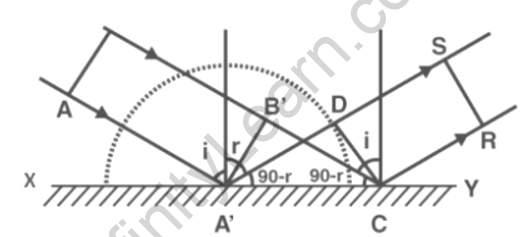Table of Contents
Laws of reflection using Huygens’ principle: What is Huygens’ principle? What are laws of reflection and how do you explain laws of reflection using Huygens’ principle? In this article, we’ll try to cover all these points while answering every question you might have on Huygens’ principle.
Christiaan Huygens (1629–1695), a Dutch scientist, developed a useful technique for determining how and where waves propagate in detail. Huygens’ principle states that starting from a known position, every point on a wavefront is a source of wavelets that spread out in the forward direction at the same speed as the wave itself. The new wavefront is perpendicular to each of the wavelets.
Applying Huygens’ principle to a wavefront passing from one medium to another can explain the law of refraction. Each wavelet was emitted when the wavefront crossed the interface between the media. Because the speed of light in the second medium is slower, the waves do not travel as far in the same amount of time, and the new wavefront changes direction as shown. This describes why, as light slows, a ray changes direction to become closer to the perpendicular.

JEE Foundation Class for 10
JEE Foundation Class for 10 enhances critical thinking and problem-solving skills through engaging activities and advanced learning techniques, ensuring academic excellence.
Overview of Huygen’s Principle
Once we look in the mirror and see ourselves, our image is actually behind the mirror. The light is coming from a direction determined by the law of reflection. The angles are set up so that our image is the same distance behind the mirror as we are away from it. If indeed the mirror is on the wall of a room, its images are all hidden behind the mirror, making the room appear larger. Although these mirror images make objects appear to be where they cannot be (such as behind a solid wall), the images are not made up. Instruments can photograph and videotape mirror images that look exactly like they do with our eyes (optical instruments).
When light reflects in the same direction from a smooth or plane surface, this is referred to as regular reflection. Let us illustrate this with an example. If a smooth surface is placed in front of a mirror, the reflecting light of a parallel ray will be parallel.
The left image of the object appears on the right, and the right image appears on the left. This type of reflection is known as lateral inversion. Irregular or diffused reflection occurs when light reflects from a rough surface in an irregular pattern. Let us illustrate this with an example. Assume light shines on a wall. The reflection of parallel light rays will not be parallel. The reflected light spreads in various directions. The law of light reflection is also at work here.
Laws of reflection
We understand that light is a type of energy that can undergo a variety of phenomena such as refraction, reflection, diffraction, and interference. A reflection of light is how light rays strike a surface and are reflected.
- As per the law of reflection, the angle of the reflected ray with respect to the normal to the surface, that is, a line perpendicular to the surface at the point of contact, is the same as the angle of the incident ray.
- The reflected ray has always been in the plane defined by the incident ray and the normal to the surface at the point where the incident ray makes contact with the surface.
Huygens’ principle
Huygens’ principle is amongst the most important principles to understand when studying waves and analyzing them. Huygens’ principle, in the core, helps us understand and describe wave motion. When you’re familiar with the concept of waves, you’re probably aware that their behaviour can be unpredictable at times.
Waves don’t generally move in a straight line and have characteristics to move in all directions. Huygens proposed in 1678 that each point on a wave’s wavefront was a source of a spherical wave. The resultant wave is calculated by adding all waves from the source point. Huygens’ principle, on the other hand, aids us in comprehending such factors and the reasoning behind them.
Huygens Principle of Secondary Wavelets – Statement
According to Huygens’ principle, also known as the Huygens–Fresnel principle, each point on a given wavefront is a source of secondary wavelets or secondary disturbances. Moreover, disturbances from the secondary source spread in all directions in the same way that disturbances from the primary source do.
This principle emphasizes additional points such as;
- Secondary sources start to generate wavelets similar to the primary source’s waves.
- The common tangent on the wavelets in the forward direction gives the new wavefront at any time.
- The sum of spherical wavelets forms the wavefront.
Huygens’ principle is a comprehensive method of analysis that can be used to understand wave propagation problems in both diffraction and reflection.

JEE Foundation Class for 9
JEE Foundation Class for 9 enhances critical thinking and problem-solving skills through engaging activities and advanced learning techniques, ensuring academic excellence.
Examples of Huygens’ Principle
- When a stone is thrown into a river, it causes waves to form around it.
- These waves, which resemble circular rings, are known as wavefront waves.
- The wavefronts gradually disperse in all directions.
- The primary wavefront is formed when the loci of all the waves in the same phase are joined.
- Every point on the primary wavefront generates a secondary wavefront.
- Furthermore, the rising tangential line encircling these secondary wavefronts can give rise to additional secondary wavefronts.
- After a while, all of the wavefronts will gradually fade away.
Outcomes of Huygens’ Principle
The following are some of the consequences of the principle:
- Huygens’ wave principle established the concept of light reflection.
- The principle also approved the concept of light refraction.
- It demonstrated the concepts of light interference and light diffraction.
- Huygens’ principle, on the other hand, failed to demonstrate the concepts of polarization of light, emission of light, absorption of light, and the photoelectric effect.
Laws of reflection using Huygens’ principle

Let us try to understand laws of reflection using Huygens’ principle here. The figure shows that AA’ represents the wavefront incident on a reflecting surface XY with an angle of incidence i. Every point on AA’ will act as a source of secondary wavelets according to Huygen’s principle.
The time taken from A’ to D = time taken from B’ to C
A’D / v = B’C / v
A’D = B’C
A’C sin(i) = A’C sin(r)
Thus, i = r
As a result, the angles of incidence and reflection are both equal. The first law of reflection also states this. Furthermore, we can test the second law of reflection because the incident wavefront AB, normal wavefront, and reflected wavefront are all on the same plane.
Also Check
Frequently Asked Questions (FAQs)
What is the first rule of law of reflection?
As per the first law of reflection, the incident ray, the reflected ray, and the normal to the surface of the mirror all lie in the same plane. All angles are measured in relation to the normal of the mirror.
How does Huygens principle explain reflection?
Huygens proposed that reflection could also be explained using the concept of wavelets. Wavelets do not change speed when reflected from the interface between the two media, as demonstrated in the tutorial, because there is no change in refractive index.
Why is Huygens principle important?
Huygens principle applies to all types of waves, along with water, sound, and light waves. It will be helpful not only for describing the propagation of light waves but also for explaining the laws of reflection and refraction.
Does Huygens principle explain refraction?
No, Huygens' principle primarily explains the behavior of wavefront propagation, not refraction, which is better explained by Snell's Law.
What is refraction and reflection of plane waves using Huygens principle?
Huygens' principle describes the creation of secondary wavelets at each point on a wavefront, explaining both refraction and reflection of plane waves.
What is the Huygens principle and explain it?
Huygens' principle states that every point on a wavefront can be considered as a source of secondary spherical waves, and the new wavefront is the envelope of these secondary waves.
What is an example of Huygens principle?
An example of Huygens' principle is how a wave propagates when a stone is thrown into a pond, creating ripples that spread outward.
What are the applications of Huygens principle?
Huygens' principle finds applications in understanding wave behavior, including diffraction, interference, and the behavior of light and sound waves.
Why is Huygens principle correct?
Huygens' principle is considered correct because it accurately predicts and explains various wave phenomena, consistent with experimental observations and mathematical models.








